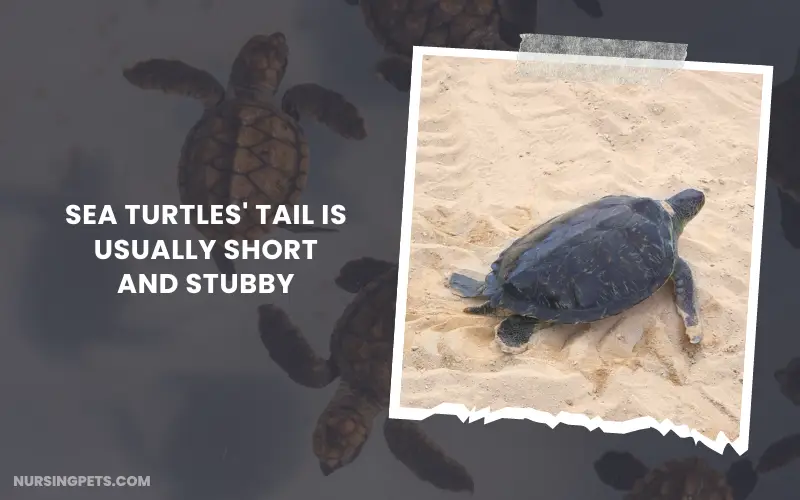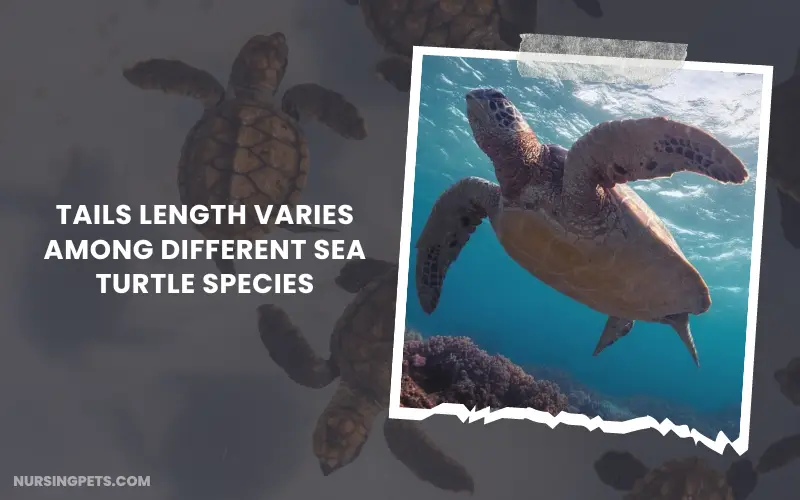Do Sea Turtles Have Tails? (Facts Of Sea Turtles)
With their serene presence and enduring lifespans, sea turtles are captivating creatures that serve as profound symbols of conservation and the delicate equilibrium of our oceans. And because of their importance, a lot of questions hover around this species’ physical makeup.
Such as, do sea turtles have tails? Yes, both male and female sea turtles have tails. But the length and form of a sea turtle’s tail may vary greatly across species. A sea turtle’s tail is often somewhat stubby and short. Male sea turtles may be identified by their bigger tail size compared to females. [source]
Swimming, balancing, and mating are just a few of the many uses for their tails. Keep reading as we discuss more about this topic to uncover everything about sea turtles and their tails. We tried to answer all the relevant questions. So, let’s get going.
Want to know more about sea turtles:
Do All Sea Turtles Have Tails?
Yes, all sea turtles have tails. It’s an integral part of their anatomy and reproductive system (the tail contains the cloaca). Once sea turtles reach sexual maturity, their tails help to distinguish between males and females.
Usually, males develop longer tails that may extend beyond their rear flippers, while females’ tails remain shorter.
And as we have mentioned before, sea turtles’ tails have specific adaptations. Their tails help them to swim and maneuver in the water. They also use them during mating and digging. But the size and shape of the tail varies among different species.

Take the leatherback sea turtle, for example. It’s the largest of all sea turtle species, yet it surprisingly has a relatively short and stubby tail compared to its massive body size. On the flip side, you have species like the green sea turtle or the loggerhead sea turtle, which boast longer tails in proportion to their bodies.
Isn’t nature amazing? Despite these variations, every species of sea turtle, be it the green sea turtle, leatherback sea turtle, loggerhead sea turtle, or any other species you can think of, all have tails that play crucial roles in their swimming abilities, maneuvering underwater, and even in activities like digging and mating.
Each tail is perfectly suited to help them thrive in their own unique way. So if you have questions like whether green sea turtles have tails, I hope you get the answer.
Do Baby Sea Turtles Have Tails?
Baby sea turtles do have tails, just like their adult counterparts. These little hatchlings rely on their tails to help them navigate and move through the sand as they make their way to the ocean; they also use them for swimming and maneuvering like adult sea turtles.

But male and female turtles often have tails of similar length when they are initially born [source]. And as they grow, the difference becomes more identifiable.
And It’s very interesting to watch them wiggle their tails and propel themselves forward. Even though their tails are smaller in proportion to their tiny bodies, they are still a crucial tool for these little adventurers. As they grow and develop into adult sea turtles, their tails will grow along with them.
Shape and Size of Sea Turtle’s Tail
Are all sea turtles’ tail lengths the same? If you thought something like that, then you are wrong. As mentioned, the length of sea turtle tails can vary among different species and individual turtles. In general, the size and length of a sea turtle’s tail depend on factors like species, sex, and age of the turtle.
Also, sea turtle species exhibit sexual dimorphism in tail length. In some species, such as green turtles, males develop longer tails than females.

The tails of male green turtles can extend past their rear flippers, while females have shorter tails. Also, the tails are typically thicker at the base and taper towards the tip.
And as explained, this is often related to reproductive functions, as the tail contains the cloaca, an opening for digestive, urinary, and reproductive tracts.
Additionally, geographic location, growth rate, food availability, and other environmental factors can influence the overall size of individual sea turtles, including the length of the tail.
So, how long is a sea turtle’s tail? Turtles’ tail sizes are not the same. And there is no universal answer to this question. They can be long or short. And the sizes depend on the species of turtle, along with their sex and age.
As a general range, most sea turtle species have tails that are around 10 to 20 centimeters (4 to 8 inches) in length, depending on the species. However, in some cases, it can reach about one foot (30 centimeters).

And as you know, the tail of a male or female turtle may look the same, but they are not. Let’s see the differences between their tails.
Male sea turtles are easily identifiable by their larger, thicker tails. It is simpler for male sea turtles to mate with females because of the pointed and curved form of their tails.
Female sea turtles have smaller, thinner tails that are only approximately 4 inches long and have a more rounded profile [source].
This is because female sea turtles build sand nests with their tails to deposit their eggs. The male turtle’s tail is too skinny and pointy to be used for this.
Now you know, male and female sea turtles may have significantly different tail sizes and shapes depending on the species.
Do Sea Turtle Tails Have Bones?
Well, there are two popular opinions we can find- one is- the tails of sea turtles are actually an extension of their backbone and are composed of a series of small bones called vertebrae. These vertebrae are connected by joints, allowing the tail to be flexible and capable of movement.

However, the tail itself does not contain any independent or separate bones. Instead, it is a continuation of the turtle’s spinal column.
The second opinion is that- turtles do really have bones in their tails. Multiple vertebrae are fused together with cartilage and surrounded by muscles and tissue to form a sea turtle’s tail. The number of vertebrae in a sea turtle’s tail varies per species but is normally between 10 and 14.
Another unpopular opinion is that sea turtle tails are primarily composed of soft tissues, muscles, and connective tissues. But do not contain bones.
The Function of Sea Turtle Tails
A sea turtle’s tail serves many essential functions for the animal. Now, let’s investigate the tail’s potential roles and why a tail is important for a sea turtle’s survival.
1. Propulsion
Sea turtle relies on its tail for propulsion which makes it an integral part of its swimming and navigational abilities.

They adjust their tails up and down and side to side to direct themselves through the water. This helps them avoid marine predators while wandering across the ocean.
2. Reproduction
You may get curious about how turtles use their tails for reproduction. As we already told, male turtles’ tails are larger than female turtles. So during mating, male turtles’ tails help them to hold the female turtle.
Also, male sea turtles have a penis located in their cloaca, and at the time of mating, they inseminate the female’s cloaca by reaching their tail underneath the posterior end of the female’s shell. This ensures the transfer of sperm for fertilization.

On the other hand, the female sea turtle uses her tail to dig holes in the sand where she will lay her eggs.
3. Nesting/Digging
In the case of female sea turtles, the tail plays a crucial role in the nesting process. When a female sea turtle comes ashore to lay her eggs, she uses her rear flippers and tail to dig a nest in the sand. The tail’s flexibility and strength allow the turtle to create a suitable cavity for her eggs, ensuring their protection until they hatch.
4. Balance and Stability
Moreover, the tail provides sea turtles balance and stability in the water. It helps maintain the turtle’s equilibrium, preventing it from rolling or flipping over while swimming; especially when they are resting, foraging, or navigating strong currents. This is also true when they are on the ground.

5. Maneuverability
Sea turtles need to be agile and maneuverable in order to navigate complex marine habitats. The tail, along with the coordination of their flippers, allows sea turtles to make precise turns, adjust their course, and navigate through obstacles.
These are the most well-known functions of the sea turtle’s tail. And you can understand why this is an important part for them.
Frequently Asked Questions
1. Do turtle’s tails always become long?
Turtles do not always have long tails. The growth rate and length of a turtle’s tail can vary depending on factors such as the species of turtle, age, and environmental conditions. Turtles generally have a slow growth rate, and their tails may grow at different rates throughout their lives.
2. Do land turtles have tails?
Land turtles, also known as tortoises, do have tails. But the tails vary in length, shape, and thickness depending on the species, and they serve functions for the turtles’ survival and behavior.
3. Do freshwater turtles have tails?
Well, freshwater turtles, like other turtles, have tails. And you know, the length and appearance of their tails can differ between males and females, also based on their species. But, in general, freshwater turtle tails are longer and more pointed than the tails of land turtles.
4. Do sea turtles use their tails to defend themselves?
It’s not for a defense that sea turtles utilize their tails. To ward off predators, they use their robust limbs and sturdy shells as a defense.
5. Can sea turtles shed their tails as some lizards do?
No, sea turtles cannot shed their tails as certain lizard species can. To survive in the water, they must have a tail, which is a permanent component of their body.
Conclusion
So now you know that all sea turtles have tails. It’s an essential part of their body that they can use for various purposes such as swimming, balancing, mating, communicating or changing directions, etc. Male and female turtles’ tails are different in size, which helps to identify the turtle’s gender.
In the end, we all can agree that the tail is a very important part of its body, and it plays many crucial roles in ocean life.
References:
- References: Do sea turtles have tails? | Olive Ridley Project. (n.d.). Retrieved from https://oliveridleyproject.org/ufaqs/do-sea-turtles-have-tails
- SeaWorld. (n.d.). Characteristics of Sea Turtles. Retrieved from https://seaworld.org/animals/all-about/sea-turtles/characteristics/
- Oliver Ridley Project. (n.d.). Do Sea Turtles Have Tails? Retrieved from https://oliveridleyproject.org/ufaqs/do-sea-turtles-have-tails/
- SEE Turtles. (n.d.). Baby Turtles. Retrieved from https://www.seeturtles.org/baby-turtles
- Britannica. (n.d.). Turtle Reproduction. Retrieved from https://www.britannica.com/animal/turtle-reptile/Reproduction

